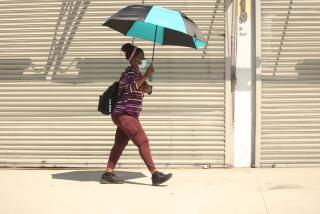DATELINE: PHOENIX : For Homeless, Heat Is as Much a Killer as Cold : City where temperatures can exceed 120 sets up emergency program for the indigent.
When the mercury reaches sizzling heights, residents cope by staying close to air conditioners, jumping into swimming pools and vacationing in cooler climates.
But those options are not available for the estimated 7,000 homeless people who live in the Phoenix metropolitan area.
For them, the heat can be deadly.
“Being homeless in Phoenix in the summer is comparable to being homeless back East in the winter in terms of potential health problems,” said Mary Ahern Kraus, director of development at the Central Arizona Shelter Services, a nonprofit shelter in a downtown area where 600 homeless people congregate.
Last year, four of those 600 were among 24 people who died in Maricopa County as a result of the high temperatures. This year, social workers and volunteers have taken the offensive against the health problems caused by the scorching Arizona sun.
They have banded together in a new program that includes offering prevention information to the homeless and distributing items such as sunscreen, hats, sunglasses, water and Gatorade.
The program seems to be working.
“We haven’t had the extreme heat we had last summer, but, so far, we’ve had no deaths” from heat among the homeless, said Patti Pritzl, manager of the county’s Homeless Health Care Outreach Program, which is coordinating the hot weather efforts.
Last year, a heat wave peaked at a record 122 degrees. This year, temperatures have been milder, with only a few days over 110 degrees.
Planning for this summer began in April. More than 20 social service and law enforcement agencies were educated about heat-related illnesses and instructed to take action when temperatures get dangerously high.
Program participants pass out fluids and other items when the thermometer reaches 105. When a temperature of 110 or above is forecast, a heat alert is declared, and workers hit the streets seeking overheated homeless people.
Many of the homeless population in downtown Phoenix have no access to drinking fountains, Pritzl said, creating a risk of dehydration, the main cause of heat-related deaths. Further aggravating the problem, she said, are the segments of homeless people who drink alcohol--increasing their dehydration risk--or take psychotropic drugs for mental illness--making their skin particularly sensitive to sun.
Pritzl said that this year’s supply budget of about $7,000 should cover the summer’s needs, barring a major heat wave. An earlier appeal for donated goods generated little response from the public.
“To us, although it’s hot and uncomfortable, it’s not deadly,” Pritzl said. “Most people in Phoenix--with their air conditioners and their pools--don’t realize what it’s like to be sunburned so badly that you have blisters all over your face.”
But, when conditions got serious at the shelter last year, Kraus said, the public did come through. In the middle of the record-breaking heat spell, the air conditioner in the men’s dormitory stopped working. The warehouse-style facility, which houses 244 men in metal bunk beds, has a concrete floor and no insulation. Staff members installed some free-standing fans, but at night the temperature inside was 101 degrees.
When the repair estimate came in at $57,000, Central Arizona Shelter Services appealed to the public for help and collected enough donations to cover the repairs.
Although the men’s dorm is nice and cool these days, the air conditioner in the main shelter building--home to 150 men, women and children, a day-care center and administrative offices--broke in April. This time, the repair bill--which includes an electrical overhaul in the 1937-era building--was estimated at $93,000.
Again, Kraus said, the shelter agency has been pleased by the response to its heated cries for help--this time directed at some of the governmental entities that contribute nearly 70% of its $2-million budget. Phoenix and Maricopa County are kicking in $70,000 and the agency can come up with the rest.
“We were really surprised,” Kraus said. “We thought we would find out that people didn’t care that homeless people were hot. But they do.”
More to Read
Sign up for Essential California
The most important California stories and recommendations in your inbox every morning.
You may occasionally receive promotional content from the Los Angeles Times.









